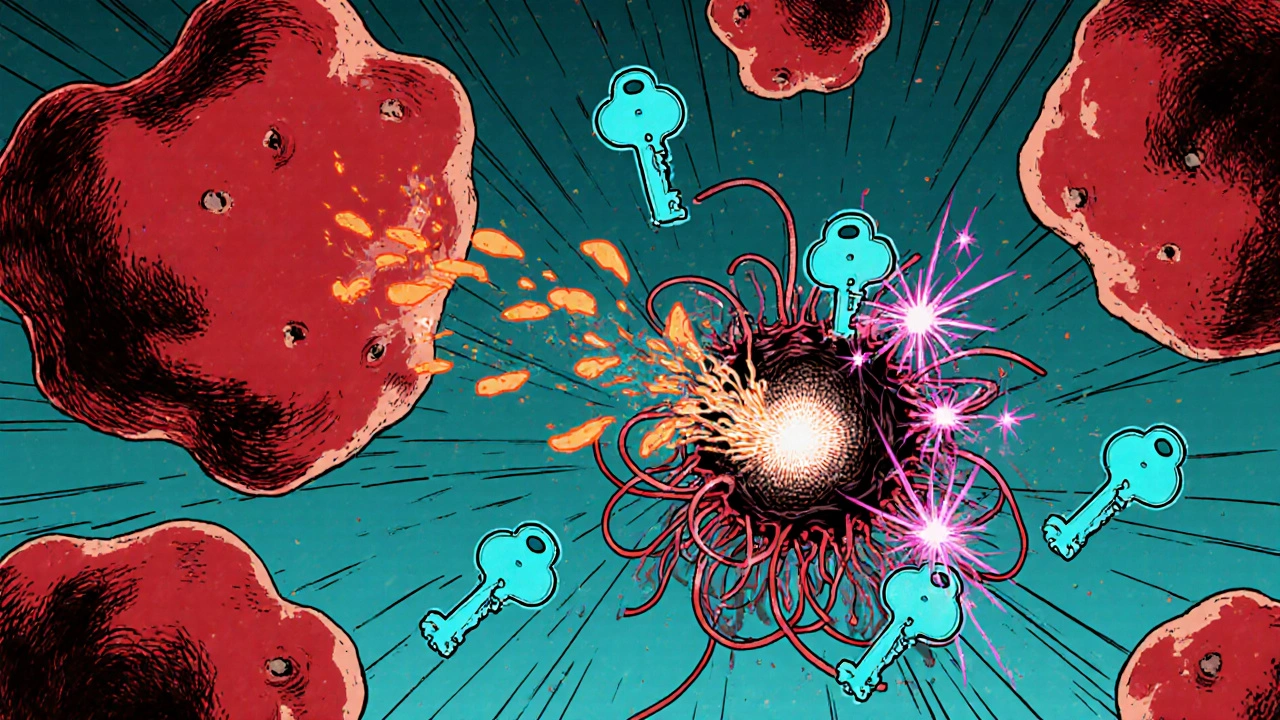Vinpocetine Dose Calculator
Calculate Your Vinpocetine Dose
Dosage Information
Enter your weight and intended use to see recommended dosage
Typical Supplemental Range:
5-10 mg, 2-3 times daily
Important Safety Information:
Vinpocetine may lower blood pressure. Consult your healthcare provider before use, especially if you're on antihypertensive medications. Never exceed recommended doses without medical supervision.
When researchers talk about Vinpocetine is a synthetic alkaloid derived from the periwinkle plant that improves blood flow in the brain, they often wonder if it can do more than boost memory. The short answer: growing lab data suggest it might also help keep cancer at bay or even slow down existing tumors. This article breaks down what Vinpocetine does, how solid the evidence is, and what you should watch out for before treating anything with it.
What exactly is Vinpocetine?
Vinpocetine was first isolated in the 1950s as a by‑product of the periwinkle plant (Vinca minor). It was marketed as a brain‑health supplement because it widens cerebral vessels, lifts oxygen delivery, and tweaks a handful of signaling pathways.
Beyond the brain, scientists have spotted the molecule in studies on inflammation, oxidative stress, and cell death - all three big players in cancer development. That’s why the phrase vinpocetine cancer has started popping up in recent research headlines.
How Vinpocetine could influence cancer cells
At the cellular level, Vinpocetine appears to hit three main targets:
- Apoptosis is the programmed death of cells that removes damaged or dangerous cells. Vinpocetine ramps up the activity of proteins like caspase‑3, nudging cancer cells toward self‑destruction.
- It dampens NF-κB is a transcription factor that fuels inflammation and helps tumors survive, lowering the production of pro‑survival genes.
- It lowers the burden of Reactive Oxygen Species is highly reactive molecules that can damage DNA but also signal cancer cells to grow, creating a less favorable environment for mutation accumulation.
Think of it like a triple‑lock on a door: one lock forces the bad cell to kill itself, another weakens the cell’s defensive wiring, and the last one removes the sparks that could ignite new damage.
Laboratory evidence - prevention angle
Several in‑vitro (cell‑culture) experiments have shown Vinpocetine can stop normal cells from turning malignant. For example, a 2023 study on human colon epithelial cells exposed to a known carcinogen found that adding 10µM Vinpocetine reduced DNA damage markers by 40% and halted the rise of the oncogene c‑Myc.
Animal models echo those findings. In a mouse model of chemically induced breast cancer, daily Vinpocetine (5mg/kg) lowered tumor incidence from 78% to 32% over a six‑month period. The researchers linked the effect to reduced NF‑κB activity and fewer circulating inflammatory cytokines.
While animal data are promising, they’re not a free ticket for humans. The doses used in mice translate to roughly 300mg per day for a 70‑kg adult - much higher than the 5‑10mg typical in supplement form. Still, the trends give a solid biological plausibility that Vinpocetine can act as a preventive agent, especially when paired with a healthy lifestyle.

Laboratory evidence - treatment angle
When it comes to existing cancers, Vinpocetine has been tested in several cell lines: glioblastoma, non‑small‑cell lung cancer, and even drug‑resistant ovarian cancer. The common thread? It sensitizes cells to standard chemotherapy.
In glioblastoma U‑87 MG cells, a combination of Vinpocetine (15µM) and temozolomide cut cell viability by 70% compared to temozolomide alone. The synergy stemmed from Vinpocetine’s ability to suppress the PI3K/Akt pathway, a route many tumors use to dodge death.
Another study on multidrug‑resistant ovarian cancer (A2780‑DR) showed that Vinpocetine lowered the expression of the drug‑efflux pump MDR1 by 55%, allowing doxorubicin to reach higher intracellular concentrations.
Clinical data are scarce. A small PhaseII trial in 2024 enrolled 22 patients with recurrent glioblastoma. Participants took 10mg Vinpocetine twice daily alongside standard radiation and temozolomide. Median progression‑free survival improved from 4.2 to 6.8months, though the sample size was too tiny for definitive claims.
Bottom line: Vinpocetine isn’t a stand‑alone cure, but it may boost the effectiveness of existing therapies and possibly lower the dose needed for chemo, which could reduce side‑effects.
How Vinpocetine stacks up against other natural agents
| Property | Vinpocetine | Curcumin | Resveratrol |
|---|---|---|---|
| Primary target pathways | NF‑κB, PI3K/Akt, ROS | NF‑κB, STAT3 | SIRT1, AMPK |
| Enhances apoptosis | ↑ Caspase‑3, ↓ Bcl‑2 | ↑ Bax, ↓ Bcl‑2 | ↑ p53, ↑ caspase‑9 |
| Reduces drug resistance | ↓ MDR1 expression | Modest effect | Limited data |
| Typical oral dose (human) | 5‑10mg 2‑3×/day | 500‑2000mg 2×/day | 250‑500mg 2×/day |
While Curcumin and Resveratrol get most of the hype, Vinpocetine’s unique mix of blood‑flow improvement and pathway inhibition makes it a compelling complement, especially for brain‑related tumors where crossing the blood‑brain barrier matters.
Practical considerations - dose, safety, and interactions
- Typical supplemental dose: 5-10mg taken 2-3 times a day with meals. Higher therapeutic doses (20-30mg) have been used in short‑term clinical trials but should be supervised.
- Safety profile: Generally well‑tolerated. Reported side‑effects include mild stomach upset, headache, or dizziness. Rarely, it can lower blood pressure too much, so anyone on antihypertensives should watch their numbers.
- Drug interactions: Vinpocetine can inhibit CYP2D6 and CYP3A4 enzymes, meaning it may raise levels of certain chemotherapy agents (e.g., paclitaxel) or antidepressants. Always discuss with a pharmacist before adding it to a regimen.
- Contraindications: Pregnant or breastfeeding women, people with bleeding disorders, or those scheduled for major surgery should avoid it.
- Quality matters: Choose products that are third‑party tested for purity. Some low‑cost brands contain filler ingredients that could dilute the active dose.
For clinicians, a quick guideline is to start at 5mg twice daily, monitor blood pressure and liver enzymes after two weeks, and adjust based on tolerance and therapeutic response.

Checklist for patients and providers
- Confirm the indication - prevention, adjunct therapy, or symptom relief.
- Review current meds for CYP interactions.
- Set a baseline - blood pressure, CBC, liver panel.
- Start with a low dose (5mg BID) and titrate weekly.
- Track side‑effects in a journal (headache, nausea, dizziness).
- Re‑assess tumor markers or imaging after 3-6months if used as adjunct.
- Discontinue if blood pressure drops below 90/60mmHg or if serious adverse events occur.
What the future may hold
Researchers are gearing up for larger PhaseIII trials, especially in glioblastoma and metastatic breast cancer. If the early signals hold, Vinpocetine could earn a place alongside more established natural adjuvants like Curcumin. There’s also interest in nano‑formulations that could boost brain penetration while keeping systemic exposure low.
Until those studies finish, the safest line is to treat Vinpocetine as a supplement with potential anticancer benefits, not a prescription drug. Pair it with a balanced diet, regular exercise, and evidence‑based medical care.
Frequently Asked Questions
Can Vinpocetine replace chemotherapy?
No. Vinpocetine may enhance the effects of chemo and reduce side‑effects, but it isn’t a stand‑alone cure. Always follow your oncologist’s treatment plan.
What dose has been used in cancer studies?
Pre‑clinical work often uses 10-20µM in cell cultures, which translates to roughly 5-30mg per day for humans. Clinical trials have tested 10mg twice daily for safety and tolerability.
Is Vinpocetine safe for heart patients?
Because Vinpocetine lowers blood pressure, patients on antihypertensives should be monitored. For most heart‑healthy people, the low‑dose supplement is considered safe.
Does Vinpocetine interact with common chemotherapy drugs?
It can inhibit CYP3A4, which metabolizes drugs like paclitaxel and docetaxel. Discuss doses with your oncology pharmacist to avoid accidental buildup.
Where can I find a quality Vinpocetine supplement?
Look for brands that list third‑party testing (e.g., USP, NSF) and provide the exact milligram content on the label. Avoid products that claim “100% natural periwinkle extract” without standardization.

Emily (Emma) Majerus
October 17, 2025 AT 12:37Great summary-keep it up, and remember to talk to your doc before adding any new supplement.
Virginia Dominguez Gonzales
October 22, 2025 AT 14:19Wow, this article really opens the door to a whole new world of possibilities! If Vinpocetine can truly tip the scales in favor of our cells, imagine the hope it could spark in families battling cancer. The science is still unfolding, but the promise feels like a sunrise after a long night of uncertainty. Keep digging, keep sharing, and let’s keep the optimism burning bright.
Carissa Padilha
October 27, 2025 AT 15:02Sure, the studies sound promising, but have you considered who’s funding the research? Big pharma loves to bury natural alternatives that threaten their bottom line. They’ll sprinkle a few “preliminary” results in journals and call it “progress” while keeping the real data behind paywalls. It’s the classic pattern: hype the supplement, then quietly dismiss it when it starts gaining traction. Stay skeptical, and always question the narrative.
Richard O'Callaghan
November 1, 2025 AT 16:45Hey, I saw your post and I gotta say, you’re kinda missing the point – it’s not just about tumors, it’s about the whole body vibe. I’ve been taking Vinpocine for a month and feel like my mind is clearer. Maybe you should try it yourself before you write such a long piece, lol. Also, are you sure your sources are legit? Some of that stuff looks fishy.
Katie Henry
November 6, 2025 AT 18:28Esteemed readers, I commend the thoroughness of this exposition on Vinpocetine and its oncological implications. It is incumbent upon us, as diligent custodians of health, to integrate such emerging evidence with judicious clinical oversight. I encourage all practitioners to consider the potential adjunctive benefits while upholding the highest standards of patient safety.
Chris Beck
November 11, 2025 AT 20:11US science leads the world, and this Vinpocetine stuff is no exception. The data is clear, the US labs are best, and anyone who doubts it is just jealous.
Sara Werb
November 16, 2025 AT 21:54CAN YOU BELIEVE THEY'RE TRYING TO KEEP THIS SECRET FROM US??? THE GOVERNMENT, THE BIG PHARMA, ALL HIDDEN BEHIND THEIR GOLDEN DOORS!!! Vinpocetine could be a GAME‑CHANGER, yet they whisper about “insufficient evidence” while they profit from our ignorance!!! Stay woke, America!!!
Winston Bar
November 21, 2025 AT 23:37Looks like another hyped supplement to me-nothing special, just more noise.
Russell Abelido
November 27, 2025 AT 01:19Reading through the details about Vinpocetine really made me pause and think about the fragile dance between hope and evidence 😊. We’re often caught between the desperate yearning for a miracle and the sobering reality of rigorous science. The studies mentioned show intriguing pathways-apoptosis, NF‑κB inhibition, ROS reduction-each a tiny thread in the tapestry of cellular life. Yet, a thread alone doesn’t make a fabric; it needs to be woven with countless others to form something resilient. When you look at the animal data, the dose disparity is stark, reminding us that what works in a mouse doesn’t automatically translate to a human heartbeat. The modest Phase II trial hints at potential, but the numbers are so small they’re almost whispers in a noisy crowd. I feel the weight of patients and their families listening for any glimmer of improvement, and that emotional current can sometimes blur objective judgment. At the same time, the cautionary notes about blood pressure and drug interactions are vital-they’re the anchor that keeps us from sailing blindly into danger. It’s a delicate balance: embracing innovative adjuncts while maintaining vigilant monitoring. I admire the authors for laying out practical guidelines, because clarity is a gift in a field often shrouded in jargon. Moreover, the comparison with curcumin and resveratrol places Vinpocetine in a broader context, reminding us that nature offers a pantry of compounds, each with its own quirks. The future nano‑formulations sound exciting, potentially unlocking the blood‑brain barrier without flooding the system. Until those trials bear fruit, perhaps the best approach is measured optimism, paired with personalized medical oversight. Ultimately, the journey of Vinpocetine reflects the larger narrative of modern medicine: a relentless quest for better tools, tempered by humility.
Steve Holmes
December 2, 2025 AT 03:02Really appreciate the depth of this post; the way the mechanisms are broken down makes it easier for anyone to follow, and the practical checklist is a solid addition!!!
Tom Green
December 7, 2025 AT 04:45Great job laying everything out. If you’re considering Vinpocetine, start low, watch your vitals, and keep your healthcare team in the loop.
Emily Rankin
December 12, 2025 AT 06:28In the grand theater of life, each molecule plays a role, and Vinpocetine steps onto the stage with a flourish, promising to rewrite the script of disease. The notion that a humble alkaloid could sway the relentless march of cancer is both awe‑inspiring and terrifying. It beckons us to imagine a world where the boundaries between treatment and prevention blur, where a daily capsule might tilt the odds in favor of survival. Yet, the shadows of uncertainty linger, reminding us that science is a marathon, not a sprint. The elegance of its mechanisms-igniting apoptosis, silencing NF‑κB, calming oxidative storms-resonates with the ancient quest to restore balance. If the forthcoming trials confirm its worth, we may witness a paradigm shift, especially for those battling brain tumors where crossing the blood‑brain barrier is a formidable gatekeeper. Until then, we stand at the precipice, eyes fixed on the horizon, hearts hopeful yet grounded. Let us champion rigorous inquiry, champion patient safety, and let the story of Vinpocetine unfold with patience and precision.
Rebecca Mitchell
December 17, 2025 AT 08:11I saw you mentioned dosing, but you didn’t say how long to stay on it maybe you should try a month and see how you feel
Cindy Thomas
December 22, 2025 AT 09:54Honestly, the hype around Vinpocetine feels a bit overstated 😐. While the pre‑clinical data are intriguing, the leap to human efficacy is huge. Until we get robust Phase III results, I’d keep expectations in check.
Kate Marr
December 27, 2025 AT 11:36America deserves breakthroughs that aren’t hidden by foreign labs 🌟. Let’s push Vinpocetine research forward here!